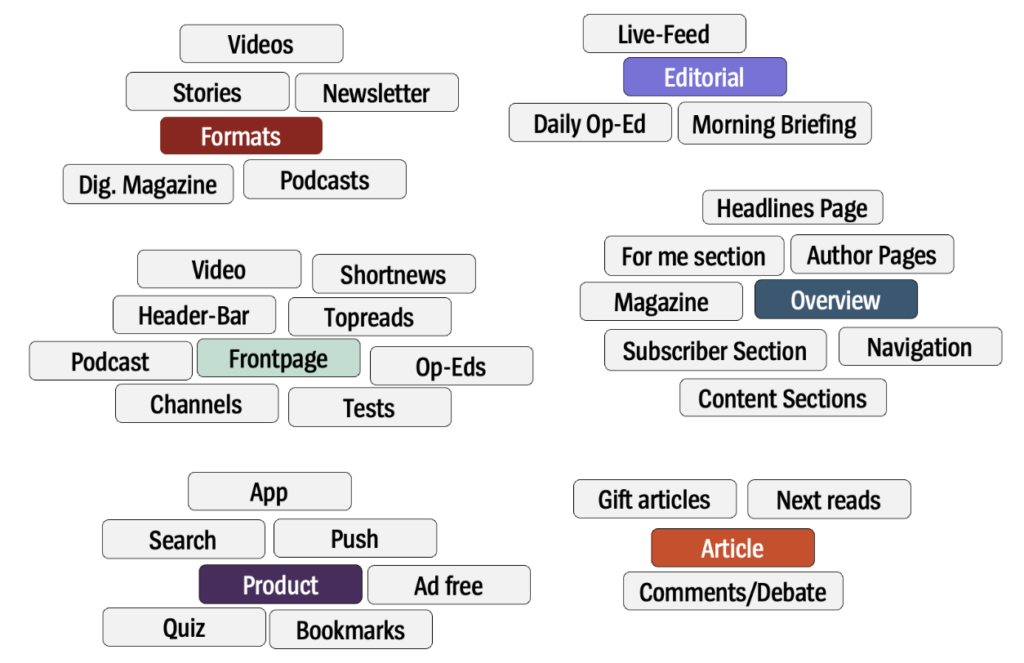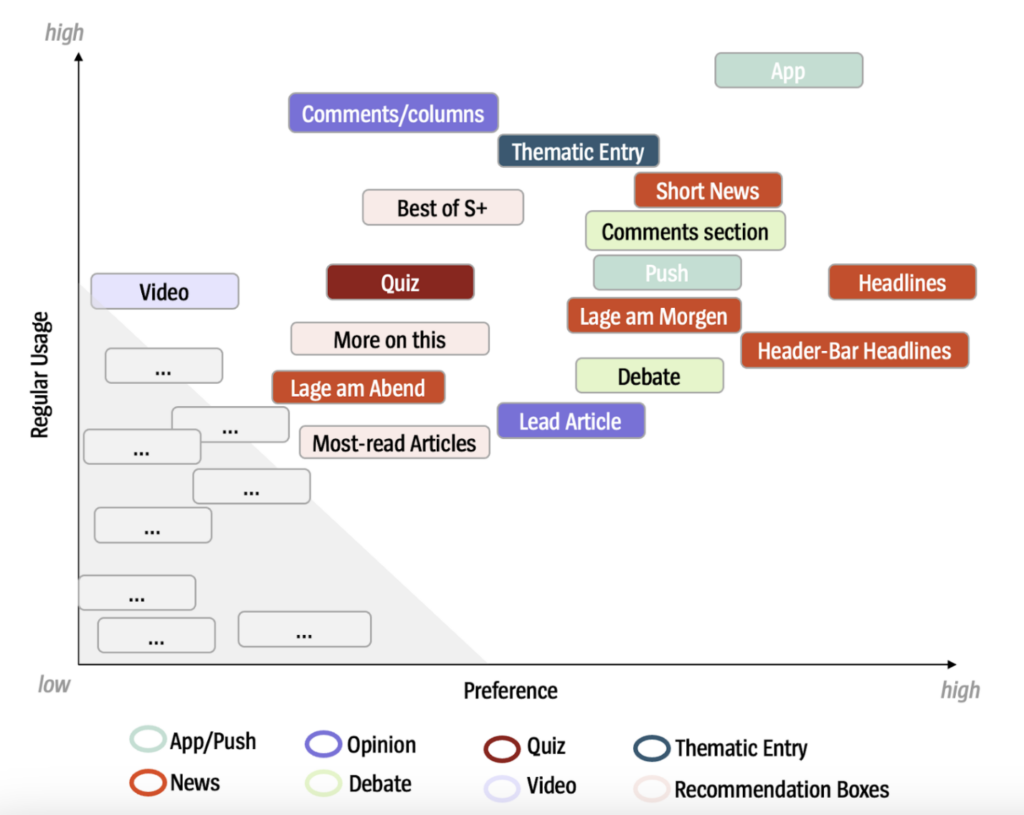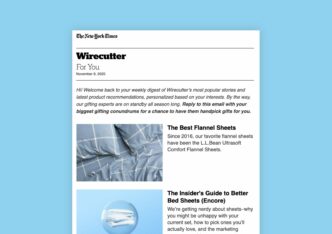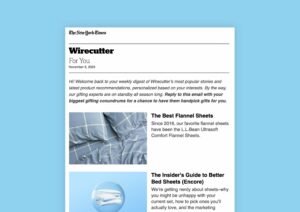

This article was co-authored by Alexander Held, Senior Data Scientist, and Angelika Zajac, qualitative researcher in the audience research department, at DER SPIEGEL.
In the subscription industry, keeping customers engaged is key to success. Earlier research indicates that engaged readers are more likely to subscribe and less likely to cancel their existing subscriptions. So how do we manage to increase the frequency and intensity of our users in a provable and sustainable way?
Besides our efforts to improve our product and business through continuous A/B testing, we are committed to gaining a comprehensive understanding of what drives engagement. Therefore, in a recent audience research initiative at DER SPIEGEL, our objective was to identify key engagement drivers. We aim to understand which editorial and product features lead to regular and deep usage, so that we can promote and explain them during onboarding and/or incorporate them into our product design considerations.
To obtain answers to these questions and identify key engagement drivers, it is important to understand the factors that influence a sporadic user’s transition to an engaged reader, including what product knowledge engaged users have and which components they have habitualized in their regular use. We do this by analyzing which features our most engaged readers use and value.
This text outlines the methodological approach we used to answer this question.
> Also by the DER SPIEGEL team: How we measure audience engagement at DER SPIEGEL
Creating a laboratory
To identify key engagement drivers, we established a laboratory-like environment through three conditions described below:
Condition 1: We start by identifying all features available to our users. “Features” can be understood as functional containers, aimed at enhancing user experience and interaction with our platform, giving users a clear and structured way to consume our content. As news constantly changes, editorial topics are explicitly not covered by these features.

Condition 2: We establish a laboratory-like setting by focusing on features that are consistently accessible on our site. Additionally, we concentrate on our most engaged users, identified through a segment based on our engagement score. This way, we create a laboratory environment characterized by the continuous presence of features and active user participation.
Condition 3: We set a threshold: A feature is considered “regularly used” if it is used by a user at least once a week (over the course of four weeks).
How do we define audience engagement? We use an engagement score as our central metric for audience engagement. Every user (with/without subscription) who has been on spiegel.de in the last 30 days gets an engagement score attached to their user profile. The score is between 0 and 100, the higher the score, the higher the engagement on spiegel.de. The score uses various key figures (e.g. frequency of visits & reading time over the last 30 days) and merges these into an overarching metric. The engagement score can be used to divide readers into segments according to their level of engagement: - Occasional: 0-25 - Regular: 25-50 - Active: 50-75 - Fans: 75-100
Methodology
Based on the laboratory conditions described above, we have chosen a mixed methods approach which enables us to gain a comprehensive understanding of our user base, their behavior, and their needs.
Hypotheses generated from guided in-depth interviews are incorporated into a subsequent survey to gain insights into which features our users are aware of, which they use and how they rate them. Looking at the behavioral data not only provides us with information about which features are used regularly and most frequently, but also tells us whether the behavior of the survey participants matches the information in the survey or whether it deviates from it. The findings from the interviews might offer explanations for these deviations.
Results
A usage-preference matrix forms the central presentation of results for this audience research project. All features are mapped in space using two axes and can therefore be compared with each other by their positioning. The Y-axis shows the observed usage values from our website tracking tool, while the X-axis shows the preferences that fans indicated in the survey.

From the ratio of behavioral and survey data eight feature groups or individual features can be identified that boost user engagement. The following interpretation is supported by a) findings from the in-depth interviews, b) by analyzing specific sub-segments, like young readers, subscribers or low engaged readers and c) by several findings from previous research:
App & Push
- Around 75% of fans use the app, making it a significant driver of engagement. It also serves as an engagement booster across different age groups.
- Push notifications are regularly used, particularly among fans under 40. Interviews showed room for product optimization, as there is a desire for more customization of which push notifications users would like to receive.
News & Update
- News features like our headlines section or our daily morning briefing “Lage am Morgen” are highly popular among SPIEGEL fans and are frequently accessed.
- All news formats are currently freely available and used by both users with and without a subscription or login.
- Live blogs (not shown in matrix) are especially favored by fans under 40.
Opinion
- Comments and columns are highly valued and regularly read. Even though positioned less prominently, it became one of the most sought-after product features on our front page.
Debate
- Interaction options are highly appreciated by users as they have a clear desire to engage and know others’ opinions. Our newly created one-topic-a-day debate feature attracts younger (under 40) users compared to the older comment section centered around each article
Quiz
- Our quiz has particularly good regular access numbers and preference ratings. It also works well for users with varying levels of engagement, including those without a login.
Video
- A relatively high percentage of fans regularly watch videos, although it is not deemed as important based on preference ratings.
- Regular video consumption is higher among users under 40 and videos have one of the highest retention rates among all features.
- We know from interviews that people particularly enjoy watching videos if they offer clear added value to what they have already read. A broken dam or the facial expressions and gestures in a political discussion can be conveyed more impressively via the medium of video.
Thematic Entry
- Thematically focused pages have high access rates among fans. Usage patterns suggest they are used when readers have ample time, possibly without paying active attention.
Recommendation Boxes
- Certain recommendation boxes, like “The Best of SPIEGEL+” and “More on This Topic,” are highly utilized, especially among subscribers.
What’s next?
Through behavioral analysis and audience research, we have shown editorial and product features that have a proven positive impact on engagement. We now aim to increase interaction rates with these key engagement drivers. First, we plan to increase the number of engaged readers by strategically nudging those with lower usage towards key engagement drivers and support the adaptation of ritualized interactions with these features. We do this by highlighting them in our mailing and onsite onboarding. Secondly, our objective is to enhance the visibility and ease of access to these engagement drivers on our front page.
Research Process and Learnings
This project provided significant insights and learning opportunities. For the first time, we documented all features on spiegel.de. This comprehensive inventory helped us understand our product offerings and identify areas for enhancement.
Combining different research methods proved highly effective. Our mixed approach gave us nuanced qualitative insights and robust quantitative data, offering a well-rounded view of user behavior and preferences. By correlating interview findings with survey results and behavioral data, we validated our hypotheses and uncovered more in-depth insights into user engagement drivers. Discussions between researchers of each method were particularly fruitful.
The project generated interest across various departments at DER SPIEGEL. Its broad scope, touching on editorial, product development, marketing, and user experience, provided a holistic view of engagement across the organization.
Thanks to Jakob Halm, Sophia Egbert, Henning Bumann and Simon Schwandner for editing and proofreading. Special thanks to Oliver Scholz for his major contribution to the quantitative work in this study.












